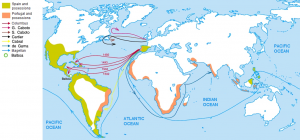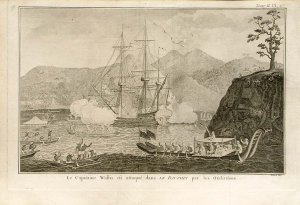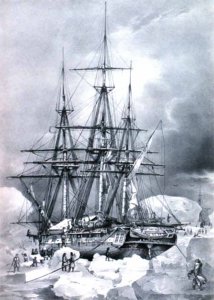The Age of Discovery, or the Age of Exploration (approximately from the beginning of the 15th century until the end of the 18th century), is an informal and loosely defined term for the period in European history in which extensive overseas exploration emerged as a powerful factor in European culture and which was the beginning of globalization. It also marks the rise of the period of widespread adoption in Europe of colonialism and mercantilism as national policies. Many lands previously unknown to Europeans were discovered by them during this period, though most were already inhabited. From the perspective of many non-Europeans, the Age of Discovery marked the arrival of invaders from previously unknown continents.
Global exploration started with the Portuguese discoveries of the Atlantic archipelagos of Madeira and the Azores in 1419 and 1427, the coast of Africa after 1434 and the sea route to India in 1498; and from the Crown of Castile (Spain), the trans-Atlantic voyages of Christopher Columbus to the Americas between 1492 and 1502 and the first circumnavigation of the globe in 1519–1522. These discoveries led to numerous naval expeditions across the Atlantic, Indian and Pacific oceans, and land expeditions in the Americas, Asia, Africa and Australia that continued into the late 19th century, and ended with the exploration of the polar regions in the 20th century.
European overseas exploration led to the rise of global trade and the European colonial empires, with the contact between the Old World (Europe, Asia and Africa) and the New World (the Americas and Australia) producing the Columbian Exchange, a wide transfer of plants, animals, food, human populations (including slaves), communicable diseases and culture between the Eastern and Western Hemispheres. This represented one of the most significant global events concerning ecology, agriculture and culture in history. The Age of Discovery and later European exploration allowed the global mapping of the world, resulting in a new worldview and distant civilizations coming into contact, but also led to the propagation of diseases that decimated populations not previously in contact with Eurasia and Africa and to the enslavement, exploitation, military conquest and economic dominance by Europe and its colonies over native populations. It also allowed for the expansion of Christianity throughout the world: with the spread of missionary activity, it eventually became the world's largest religion.

Map with the main travels of the Age of Discovery. See details in expandable table:
Contents
Maritime exploration in the Age of Discovery
From the early 15th century to the early 17th century the Age of Discovery had, through Spanish and Portuguese seafarers, opened up southern Africa, the Americas (New World), Asia and Oceania to European eyes: Bartholomew Dias had sailed around the Cape of southern Africa in search of a trade route to India; Christopher Columbus, on four journeys across the Atlantic, had prepared the way for European colonisation of the New World; Ferdinand Magellan had commanded the first expedition to sail across the Atlantic and Pacific oceans to complete the first circumnavigation of the Earth. Over this period colonial power shifted from the Portuguese and Spanish to the Dutch and then the British and French. The new era of scientific exploration began in the late 17th century as scientists, and in particular natural historians, established scientific societies that published their researches in specialist journals. The British Royal Society was founded in 1660 and encouraged the scientific rigour of empiricism with its principles of careful observation and deduction. Activities of early members of the Royal Society served as models for later maritime exploration. Hans Sloane (1650–1753) was elected a member in 1685 and travelled to Jamaica from 1687 to 1689 as physician to the Duke of Albemarle (1653–1688) who had been appointed Governor of Jamaica. In Jamaica Sloane collected numerous specimens which were carefully described and illustrated in a published account of his stay. Sloane bequeathed his vast collection of natural history 'curiosities' and library of over 50,000 bound volumes to the nation, prompting the establishment in 1753 of the British Museum. His travels also made him an extremely wealthy man as he patented a recipe that combined milk with the fruit of Theobroma cacao(cocoa) he saw growing in Jamaica, to produce milk chocolate. Books of distinguished social figures like the intellectual commentator Jean Jacques Rousseau, Director of the Paris Museum of Natural History Comte de Buffon, and scientist-travellers like Joseph Banks, and Charles Darwin, along with the romantic and often fanciful travelogues of intrepid explorers, increased the desire of European governments and the general public for accurate information about the newly discovered distant lands.
One of the earliest French expeditions on the coasts of Africa, South America and through the Strait of Magellan was made by a squadron of French men-of-war under the command of M. de Gennes in 1695–97. The young French explorer, engineer and hydrographer François Froger described this expedition in his A Relation of a Voyage (1699).

 en.wikipedia.org
en.wikipedia.org
Global exploration started with the Portuguese discoveries of the Atlantic archipelagos of Madeira and the Azores in 1419 and 1427, the coast of Africa after 1434 and the sea route to India in 1498; and from the Crown of Castile (Spain), the trans-Atlantic voyages of Christopher Columbus to the Americas between 1492 and 1502 and the first circumnavigation of the globe in 1519–1522. These discoveries led to numerous naval expeditions across the Atlantic, Indian and Pacific oceans, and land expeditions in the Americas, Asia, Africa and Australia that continued into the late 19th century, and ended with the exploration of the polar regions in the 20th century.
European overseas exploration led to the rise of global trade and the European colonial empires, with the contact between the Old World (Europe, Asia and Africa) and the New World (the Americas and Australia) producing the Columbian Exchange, a wide transfer of plants, animals, food, human populations (including slaves), communicable diseases and culture between the Eastern and Western Hemispheres. This represented one of the most significant global events concerning ecology, agriculture and culture in history. The Age of Discovery and later European exploration allowed the global mapping of the world, resulting in a new worldview and distant civilizations coming into contact, but also led to the propagation of diseases that decimated populations not previously in contact with Eurasia and Africa and to the enslavement, exploitation, military conquest and economic dominance by Europe and its colonies over native populations. It also allowed for the expansion of Christianity throughout the world: with the spread of missionary activity, it eventually became the world's largest religion.

Map with the main travels of the Age of Discovery. See details in expandable table:
Contents
- 1 Overview
- 2 Background
- 3 Atlantic Ocean (1419–1507)
- 4 Indian Ocean (1497–1513)
- 5 Pacific Ocean (1513–1529)
- 6 Inland Spanish conquistadores (1519–1532)
- 7 New trade routes (1542–1565)
- 8 Northern European involvement (1595 – 17th century)
- 9 Russian exploration of Siberia (1581–1660)
- 10 Global impact
- 11 See also
- 12 References
- 13 Further reading
- 14 External links
Maritime exploration in the Age of Discovery
From the early 15th century to the early 17th century the Age of Discovery had, through Spanish and Portuguese seafarers, opened up southern Africa, the Americas (New World), Asia and Oceania to European eyes: Bartholomew Dias had sailed around the Cape of southern Africa in search of a trade route to India; Christopher Columbus, on four journeys across the Atlantic, had prepared the way for European colonisation of the New World; Ferdinand Magellan had commanded the first expedition to sail across the Atlantic and Pacific oceans to complete the first circumnavigation of the Earth. Over this period colonial power shifted from the Portuguese and Spanish to the Dutch and then the British and French. The new era of scientific exploration began in the late 17th century as scientists, and in particular natural historians, established scientific societies that published their researches in specialist journals. The British Royal Society was founded in 1660 and encouraged the scientific rigour of empiricism with its principles of careful observation and deduction. Activities of early members of the Royal Society served as models for later maritime exploration. Hans Sloane (1650–1753) was elected a member in 1685 and travelled to Jamaica from 1687 to 1689 as physician to the Duke of Albemarle (1653–1688) who had been appointed Governor of Jamaica. In Jamaica Sloane collected numerous specimens which were carefully described and illustrated in a published account of his stay. Sloane bequeathed his vast collection of natural history 'curiosities' and library of over 50,000 bound volumes to the nation, prompting the establishment in 1753 of the British Museum. His travels also made him an extremely wealthy man as he patented a recipe that combined milk with the fruit of Theobroma cacao(cocoa) he saw growing in Jamaica, to produce milk chocolate. Books of distinguished social figures like the intellectual commentator Jean Jacques Rousseau, Director of the Paris Museum of Natural History Comte de Buffon, and scientist-travellers like Joseph Banks, and Charles Darwin, along with the romantic and often fanciful travelogues of intrepid explorers, increased the desire of European governments and the general public for accurate information about the newly discovered distant lands.
One of the earliest French expeditions on the coasts of Africa, South America and through the Strait of Magellan was made by a squadron of French men-of-war under the command of M. de Gennes in 1695–97. The young French explorer, engineer and hydrographer François Froger described this expedition in his A Relation of a Voyage (1699).







